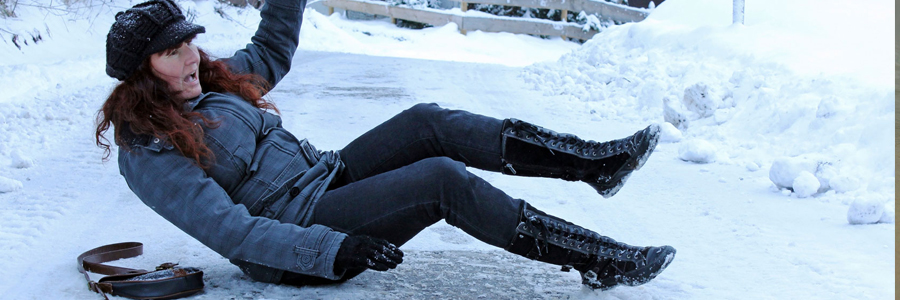11 Important Winter Safety Tips all Canadians Should Know
Winter in Canada can be beautiful, with fresh layers of glistening white snow coating the trees and a shiny layer of frost on the grass. But winter can also be dangerous, and all Canadians should know the right winter safety tips to stay safe and enjoy this chilly time of year.
From low visibility on the road to icy sidewalks, there are many ways that someone can suffer an injury in the winter. And sometimes, it’s not our fault.
Here are 11 essential winter safety tips that everyone needs to know to get through the winter season. While these won’t help you prevent accidents completely, they’ll help you stay prepared.

1. Always Check Weather Conditions
Canadian winter weather conditions can change from one minute to the next. Always check the weather before you leave the house, and be aware of any predicted storms coming your way.
When there’s a storm coming, consider how badly you need to leave your home. Are you just going to visit a friend, or are you going to work? Can you justify waiting out the storm?
If you really need to leave the house, take extra precautions and bring a survival kit with you. Bring an extra coat, hat, scarf, and gloves, as well as some extra wiper fluid or salt incase you get stuck.

2. Practice Safe Driving in Winter
Ontario drivers already understand the value of safe driving in winter. Not only could safe driving save your life, but it could also save the lives of other drivers.
Understand the best winter driving tips and safety precautions before you hit the road. These precautions include lowering speed, snow removal from the roof of your car, and keeping a safe distance behind other cars.
Additionally, in Ontario winter tires get you a discount on your car insurance, so there’s even more incentive for being safe.
3. Pay Attention to Sidewalk Shovelling Laws
Ontario sidewalk shovelling laws state that if you are a homeowner, you’re responsible for shoveling your sidewalk. In major cities, mechanical snow shovelling services will clear sidewalks in busy downtown areas and on public property, but you are responsible for your own property.
In Toronto, home or business owners are required to clear the sidewalks in front of their buildings within 12 hours of a snowfall. If you neglect to do this, you could face a $100 fine and a potential personal injury lawsuit if anyone slips and falls on your property.

4. Wear Proper Winter Clothing
If you’re walking in the winter, make sure you’re wearing proper winter boots. When you slip and fall on ice, winter boots can help absorb the impact or prevent you from slipping as much.
Additionally, your case might not be as strong if the courts see that you didn’t bother to wear proper winter footwear, as this can be considered partially your own fault.
5. Obey Ontario Snowmobiling Laws
Snowmobiling in Ontario is an awesome way to enjoy the weather and get out and have some fun. But there are laws in this province that you need to follow to stay safe.
In addition, there are regulations about where and when you can snowmobile, for your safety and the safety of other drivers.
Get the best snowmobiling tips and read up on the laws before you head out.

6. Hike, Camp, or Cross Country Ski With Caution
Canadians know how to make the most out of a cold, snowy winter. Outdoor activities, like hiking, camping, snowshoeing, and cross country skiing, are fun ways to get outdoors, but they require certain winter safety precautions.
Always tell someone where you’re going and how long you’re going to be. Plan to get back to your campsite or at home by sunset so you don’t get caught in the dark, when temperatures and visibility drop.
Additionally, be sure to wear layers and account for extra food or clothing in case of an emergency.
7. Cat Litter Can Provide Traction in a Pinch
When there’s a storm, you don’t always have time to run out and buy more salt or sand if you run out. If you didn’t check your supply before the storm hit, and you’re a cat owner, you have a backup on hand.
Cat litter can provide traction on ice when you don’t have salt or sand. It won’t last for a long time, but it will help until you can get some proper salt.

8. Keep an Emergency Car Kit
If you travel anywhere, regardless of the season, you should have an emergency car kit in your vehicle. Keep it stocked with essentials like extra food and water, blankets, and flashlights.
For winter driving, your emergency car kit should include a few extra things, like a folding shovel, salt or sand, and gloves or hats.
9. Take Precautions Before You Start Shoveling Snow
Did you know that consuming nicotine or caffeine before you shovel snow can actually decrease your heart rate and can potentially cause your blood vessels to constrict? This is dangerous and could cause a heart attack or other cardiovascular problems from the strain of shoveling.
It’s also important to warm up before you start shoveling. Shoveling is a workout in itself! Just like you would at the gym, warming up before shoveling could prevent back and muscle injuries.
10. Keep Your Hands Out of Your Pockets and Free While You Walk
If you slip and fall on ice, you need to have your hands free to break your fall. Don’t keep them in your pockets, where you won’t get them out in time.
Additionally, avoid carrying things or using your phone while you walk so you can have them ready in the case of an accident. This will also help you keep your balance and avoid falling in the first place.

11. Take Pictures of Any Accidents
If you slip and fall on ice not cleared properly, and you decide to take the injury to court, you’ll need to take photos as soon as the accident happens.
In the winter, ice and snow conditions can change within a few hours. Ice and snow can melt, leaving you with little proof that the ice you slipped on was there in the first place.
Always make sure you take pictures immediately to help build your case and get the right settlement.

If You Suffer a Winter Injury, Contact Conte & Associates Now
Slipped on an icy sidewalk? Rear-ended by someone who didn’t have snow tires? Conte & Associates can help.
We know that accidents happen, but when it’s someone else’s fault, they need to be held accountable. That’s why we fight for you.
Our team of aggressive and experienced personal injury lawyers in Toronto will get you the settlement you deserve. It’s time to move on with your life, and we’ll help you get started.
Contact Conte & Associates today to book your free consultation. Accidents can change your life, but we can change the outcome.





